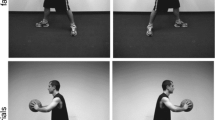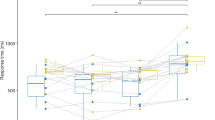Abstract
In basketball, the defender’s reaction to a pass is slower and more error prone if the attacking player gazes into the opposite direction. This so-called head-fake effect might be modulated by context information, that is, the frequency and the sequence of head fakes occurring. Accordingly, the present study investigates the head-fake effect for different frequency proportions (20% vs. 50% vs. 80%). The results show that the head-fake effect decreases when the head fake occurs more often. Furthermore, a potential influence of previous fake experience (i.e., congruency-sequence effect) on the size of the head-fake effect was investigated. Importantly, previous fake experience did not cause the frequency-based modulation of the general size of the head-fake effect. These findings bare important implications for sports practice, especially when it comes to instructing players about the tactical use of deceptive actions.
Zusammenfassung
Im Basketball ist die Reaktion des Verteidigers auf einen Pass langsamer und stärker fehlerbehaftet, wenn der angreifende Spieler in die entgegengesetzte Richtung schaut. Dieser sogenannte Blicktäuschungseffekt („head-fake effect“) könnte durch Kontextinformationen moduliert werden, genauer durch die Häufigkeit und Sequenz von Blicktäuschungen. Daher wurde in der vorliegenden Studie der Blicktäuschungseffekt bei unterschiedlichen Häufigkeitsverhältnissen (20 % vs. 50 % vs. 80 %) untersucht. Im Ergebnis nahm der Effekt mit steigender Häufigkeit der Blicktäuschungen ab. Des Weiteren wurde der potenzielle Einfluss vorausgegangener Täuschungserfahrungen, das heißt der Kongruenz-Sequenz-Effekt, auf die Größe des Blicktäuschungseffekts untersucht. Im Wesentlichen verursachten frühere Täuschungserfahrungen nicht die häufigkeitsbasierte Modulation der allgemeinen Größe des Blicktäuschungseffekts. Diese Ergebnisse sollten bedeutende Auswirkungen auf die sportliche Praxis haben, insbesondere auf die Anleitung von Spielern bezüglich der taktischen Nutzung von Täuschungshandlungen.



Similar content being viewed by others
Notes
The instruction is identical with the one used in previous studies on the head-fake effect in basketball.
(e.g., Weigelt et al., 2017; Kunde et al., 2011). It focuses on gaze direction (and not on head orientation), as gaze direction has been shown to be a special attentional cue, which triggers reflexive shifts of attention in an observer (Langton, Watt, & Bruce, 2000). Of course, both the head orientation and the gaze direction might be responsible for the head-fake effect.
References
Abernethy, B., Gill, D. P., Parks, S. L., & Packer, S. T. (2001). Expertise and the perception of kinematic and situational probability information. Perception, 30(2), 233–252.
Adams, J. A. (1971). A closed-loop theory of motor learning. Journal of Motor Behavior, 3(2), 111–149.
Alhaj Ahmad Alaboud, M., Steggemann, Y., Klein-Soetebier, T., Kunde, W., & Weigelt, M. (2012). Täuschungshandlungen im Sport. Eine experimentelle Untersuchung zur Wirkung der Häufigkeitsverteilung auf die Blicktäuschung im Basketball [Deceptive actions in sports: An experimental investigation on the influence of the frequency distribution oft he head fake in basketball. Zeitschrift für Sportpsychologie, 19(3), 110–121.
Alhaj Ahmad Alaboud, M., Güldenpenning, I., Steggemann-Weinrich, Y., Kunde, W., & Weigelt, M. (2016). Täuschungshandlungen im Sport: Der Blicktäuschungseffekt im Basketball unter quasirealistischen Bedingungen [Deceptive actions in sports: The head-fake effect in basketball under quasi-realistic conditions. Sportwissenschaft, 46(3), 223–231.
Bishop, D. T., Wright, M. J., Jackson, R. C., & Abernethy, B. (2013). Neural bases for anticipation skill in soccer: an FMRI study. Journal of Sport and Exercise Psychology, 35, 98–109.
Brault, S., Bideau, B., Kulpa, R., & Craig, C. M. (2012). Detecting deception in movement: the case of the side-step in rugby. PLoS One, 7(6), 1–13.
Cañal-Bruland, R., & Mann, D. L. (2015). Time to broaden the scope of research on anticipatory behavior: a case for the role of probabilistic information. Frontiers in Psychology, 6, 1518.
Cañal-Bruland, R., & Schmidt, M. (2009). Response bias in judging deceptive movements. Acta Psychologica, 130(3), 235–240.
Cañal-Bruland, R., van der Kamp, J., & van Kesteren, J. (2010). An examination of motor and perceptual contributions to the recognition of deception from others’ actions. Human Movement Science, 29(1), 94–102.
Egner, T. (2014). Creatures of habit (and control): a multi-level learning perspective on the modulation of congruency effects. Frontiers in Psychology, 5, 1247.
Egner, T., Ely, S., & Grinband, J. (2010). Going, going, gone: characterizing the time-course of congruency sequence effects. Frontiers in Psychology, 1, 154.
Farrow, D., & Reid, M. (2012). The contribution of situational probability information to anticipatory skill. Journal of Science and Medicine in Sport, 15(4), 368–373.
Gratton, G., Coles, M. G. H., & Donchin, E. (1992). Optimizing the use of information: Strategic control of activation of responses. Journal of Experimental Psychology: General, 121(4), 480–506.
Gray, R. (2002). Behavior of college baseball players in a virtual batting task. Journal of Experimental Psychology. Human Perception and Performance, 28, 1131–1148.
Güldenpenning, I., Kunde, W., & Weigelt, M. (2017). How to trick your opponent: a review article on deceptive actions in interactive sports. Frontiers in Psychology, 8, 917. https://doi.org/10.3389/fpsyg.2017.00917.
Henry, G., Dawson, B., Lay, B., & Young, W. (2012). Effects of a feint on reactive agility performance. Journal of Sports Sciences, 30(8), 787–795.
Jackson, R. C., Warren, S., & Abernethy, B. (2006). Anticipation skill and susceptibility to deceptive movements. Acta Psychologica, 123(3), 355–371.
Kunde, W., Skirde, S., & Weigelt, M. (2011). Trust my face: cognitive factors of head fakes in sports. Journal of Experimental Psychology: Applied, 17(2), 110–127.
Langton, S. R., Watt, R. J., & Bruce, V. (2000). Do the eyes have it? Cues to the direction of social attention. Trends in Cognitive Sciences, 4(2), 50–59.
Loffing, F., & Cañal-Bruland, R. (2017). Anticipation in sport. Current Opinion in Psychology, 16, 6–11. https://doi.org/10.1016/j.copsyc.2017.03.008.
Loffing, F., & Hagemann, N. (2014). On-court position influences skilled tennis players’ anticipation of shot outcome. Journal of Sport & Exercise Psychology, 36(1), 14–26.
Loffing, F., Stern, R., & Hagemann, N. (2015). Pattern-induced expectation bias in visual anticipation of action outcomes. Acta Psychologica, 161, 45–53.
Logan, G. D. (1980). Attention and automaticity in Stroop and priming tasks: theory and data. Cognitive Psychology, 12, 523–553.
Lowe, D. G., & Mitterer, J. O. (1982). Selective and divided attention in a Stroop task. Canadian Journal of Psychology, 36, 684–700.
MacLeod, C. M. (1991). Half a century of research on the stroop effect: an integrative review. Psychological Bulletin, 109, 163–203.
Mann, D. L., Schaefers, T., & Cañal-Bruland, R. (2014). Action preferences and the anticipation of action outcomes. Acta Psychologica, 152, 1–9.
Prinz, W. (1997). Perception and action planning. European Journal of Cognitive Psychology, 9(2), 129–154.
Rowe, R., Horswill, M. S., Kronvall-Parkinson, M., Poulter, D. R., & McKenna, F. P. (2009). The effect of disguise on novice and expert tennis players’ anticipation ability. Journal of Applied Sport Psychology, 21(2), 178–185.
Schmidt, J. R., & Besner, D. (2008). The Stroop effect: Why proportion congruent has nothing to do with congruency and everything to do with contingency. Journal of Experimental Psychology: Learning, Memory, and Cognition, 34(3), 514.
Stürmer, B., Leuthold, H., Soetens, E., Schröter, H., & Sommer, W. (2002). Control over location-based response activation in the Simon task: Behavioral and electrophysiological evidence. Journal of Experimental Psychology: Human Perception and Performance, 28(6), 1345–1363.
Verguts, T., Notebaert, W., Kunde, W., & Wühr, P. (2011). Post-conflict slowing: cognitive adaptation after conflict processing. Psychonomic Bulletin & Review, 18(1), 76–82.
Weigelt, M., Güldenpenning, I., Steggemann-Weinrich, Y., Alhaj Ahmad Alaboud, M., & Kunde, W. (2017). Control over the processing of the opponent’s gaze direction in basketball experts. Psychonomic Bulletin & Review,, 24(3), 828.
Wendt, M., & Luna-Rodriguez, A. (2009). Conflict-frequency affects flanker interference: role of stimulus-ensemble-specific practice and flanker-response contingencies. Experimental Psychology, 56(3), 206–217.
Wright, M. J., & Jackson, R. C. (2014). Deceptive body movements reverse spatial cueing in soccer. PLoS One, 9(8), 1–9.
Wühr, P., & Kunde, W. (2008). Pre-cueing spatial S‑R correspondence: Is there regulation of expected response conflict? Journal of Experimental Psychology: Human Perception and Performance, 34(4), 872–883.
Funding
This work was supported by a grant of the German Research Foundation (DFG) awarded to the first author (GU 1683/1-1) and the third author (KU 1964/13-1) of the manuscript.
Author information
Authors and Affiliations
Corresponding author
Ethics declarations
Conflict of interest
I. Güldenpenning, M. Alhaj Ahmad Alaboud, W. Kunde, and M. Weigelt declare that they have no competing interests.
All procedures performed in studies involving human participants were in accordance with the ethical standards of the institutional and/or national research committee and with the 1964 Helsinki declaration and its later amendments or comparable ethical standards. Informed consent was obtained from all individual participants included in the study.
Caption Electronic Supplementary Material
Example of the stimulus material used in the study 1
Example of the stimulus material used in the study 2
Rights and permissions
About this article
Cite this article
Güldenpenning, I., Alaboud, M.A.A., Kunde, W. et al. The impact of global and local context information on the processing of deceptive actions in game sports. Ger J Exerc Sport Res 48, 366–375 (2018). https://doi.org/10.1007/s12662-018-0493-4
Received:
Accepted:
Published:
Issue Date:
DOI: https://doi.org/10.1007/s12662-018-0493-4
Keywords
- Deceptive action
- Local context information
- Global context information
- Fake frequency
- Congruency-sequence effect




